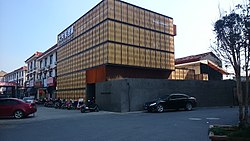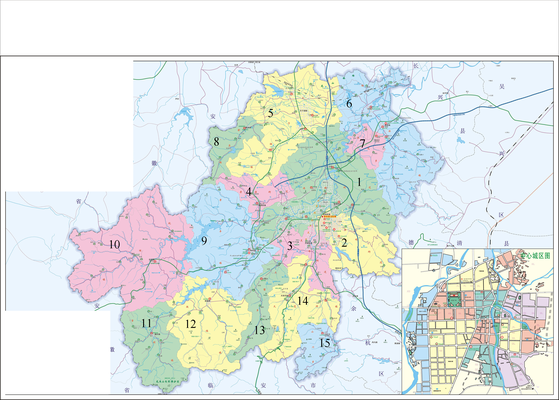Anji
安吉县 Anchi | |
|---|---|
 | |
| Coordinates: 30°37′48″N 119°40′17″E / 30.63000°N 119.67139°E | |
| Country | People's Republic of China |
| Province | Zhejiang |
| Prefecture-level city | Huzhou |
| Origins | 200 AD |
| Seat | Changshuo Subdistrict |
| Government | |
| • County Head | Ning Yun[1] |
| Area | |
| • Total | 1,886 km2 (728.19 sq mi) |
| Elevation | 20 to 1,600 m (65 to 5,250 ft) |
| Population (2013) | |
| • Total | 461,800 |
| • Density | 244.9/km2 (634.2/sq mi) |
| Time zone | UTC+8 (China Standard Time (CST)) |
| Postal code | 313300 to 313310 |
| Area code | 0572 |
| Languages | Anji dialect, Mandarin Chinese, Southern Min |
| Website | www |
Anji County (ⓘsimplified Chinese: 安吉县; traditional Chinese: 安吉縣; pinyin: Ānjí Xiàn) is a county in the prefecture-level city of Huzhou in northwestern Zhejiang province, China. The county spans an area of 1,886 square kilometres (728 sq mi),[2] with a population of 461,800 as of the end of 2013.[3] Located within the Yangtze River Delta, Anji County is a short distance from Shanghai, Hangzhou, and Nanjing.[4]
Anji County is known for its lush natural environment, with over 70% of the county's area covered in forest and other vegetation.[2] In particular, Anji County is known for its bamboo production.[2] The county has 60,000 hectares (150,000 acres) of bamboo groves containing over 40 different species of bamboo.[citation needed]
The county is home to the Tianhuangping Pumped Storage Power Station.
Toponymy[edit]
Anji County is named after a verse from the Classic of Poetry.[2]
History[edit]
The Shangmakan site, a paleolithic archeological site, is located within present-day Anji County.[2]
Anji County was established in 185 CE.[2]
During the 1990s, it took more than two hours to travel to Hangzhou by bus.[citation needed] Poor transportation isolated Anji from the rest of Zhejiang Province, and for many years its economy remained underdeveloped.[citation needed] From 1997 to 2000, highways were built to Hangzhou and Huzhou, and from 2000 to 2002, highways connecting to National Highway G318 were constructed.[citation needed] The provincial highways within its boundary were also widened.[citation needed] Now the highway system traversing the entire boundary has been completed, and it takes less than three hours to reach Shanghai, Nanjing or Suzhou, and less than one hour to get to Hangzhou and Huzhou.[citation needed]
Geography[edit]
Anji County is located within the Yangtze Delta,[4] where the Yangtze meets the East China Sea. The Tianmu Mountains run through southwest portion of the county, with the county's highest point, Longwang Mountain, reaching 1,587.4 metres (5,208 ft) in elevation.[4] Xitiao River, the county's longest river, flows from the southwest mountains northeast, before eventually emptying into Lake Tai.[4]
Anji County is bordered by Changxing County to the north, Wuxing District and Deqing County to the east, Yuhang District and Lin'an District (both in Hangzhou) to the south, and by Ningguo and Guangde to the west (both in Xuancheng, Anhui).[4] The county is located 65 kilometres (40 mi) north of Hangzhou's urban core, and 223 kilometres (139 mi) to the west of Shanghai's.[4]
Climate[edit]
| Climate data for Anji (1991–2020 normals, extremes 1981–2010) | |||||||||||||
|---|---|---|---|---|---|---|---|---|---|---|---|---|---|
| Month | Jan | Feb | Mar | Apr | May | Jun | Jul | Aug | Sep | Oct | Nov | Dec | Year |
| Record high °C (°F) | 24.8 (76.6) |
28.6 (83.5) |
34.4 (93.9) |
36.1 (97.0) |
37.2 (99.0) |
38.8 (101.8) |
40.7 (105.3) |
40.9 (105.6) |
38.6 (101.5) |
35.5 (95.9) |
30.1 (86.2) |
25.4 (77.7) |
40.9 (105.6) |
| Mean daily maximum °C (°F) | 8.5 (47.3) |
11.4 (52.5) |
16.3 (61.3) |
22.6 (72.7) |
27.3 (81.1) |
29.7 (85.5) |
33.8 (92.8) |
33.0 (91.4) |
28.5 (83.3) |
23.6 (74.5) |
17.7 (63.9) |
11.3 (52.3) |
22.0 (71.6) |
| Daily mean °C (°F) | 3.8 (38.8) |
6.1 (43.0) |
10.5 (50.9) |
16.4 (61.5) |
21.5 (70.7) |
24.7 (76.5) |
28.4 (83.1) |
27.8 (82.0) |
23.4 (74.1) |
17.7 (63.9) |
11.8 (53.2) |
5.8 (42.4) |
16.5 (61.7) |
| Mean daily minimum °C (°F) | 0.3 (32.5) |
2.2 (36.0) |
6.0 (42.8) |
11.4 (52.5) |
16.6 (61.9) |
20.8 (69.4) |
24.4 (75.9) |
24.2 (75.6) |
19.6 (67.3) |
13.4 (56.1) |
7.4 (45.3) |
1.7 (35.1) |
12.3 (54.2) |
| Record low °C (°F) | −13.5 (7.7) |
−10.0 (14.0) |
−4.5 (23.9) |
−1.6 (29.1) |
5.7 (42.3) |
11.0 (51.8) |
17.4 (63.3) |
17.1 (62.8) |
7.8 (46.0) |
0.2 (32.4) |
−5.6 (21.9) |
−12.4 (9.7) |
−13.5 (7.7) |
| Average precipitation mm (inches) | 85.9 (3.38) |
81.1 (3.19) |
120.2 (4.73) |
104.2 (4.10) |
127.7 (5.03) |
238.1 (9.37) |
190.3 (7.49) |
202.2 (7.96) |
116.5 (4.59) |
81.3 (3.20) |
72.2 (2.84) |
58.3 (2.30) |
1,478 (58.18) |
| Average precipitation days (≥ 0.1 mm) | 12.9 | 12.0 | 14.7 | 13.6 | 13.4 | 15.7 | 14.7 | 15.9 | 12.2 | 8.6 | 10.3 | 9.7 | 153.7 |
| Average snowy days | 4.0 | 2.8 | 1.0 | 0 | 0 | 0 | 0 | 0 | 0 | 0 | 0.4 | 1.8 | 10 |
| Average relative humidity (%) | 78 | 76 | 74 | 72 | 72 | 79 | 78 | 79 | 80 | 78 | 79 | 77 | 77 |
| Mean monthly sunshine hours | 113.4 | 114.2 | 138.4 | 159.4 | 172.5 | 137.8 | 204.8 | 187.3 | 151.9 | 160.2 | 135.9 | 130.8 | 1,806.6 |
| Percent possible sunshine | 35 | 36 | 37 | 41 | 41 | 33 | 48 | 46 | 41 | 46 | 43 | 42 | 41 |
| Source: China Meteorological Administration[5][6] | |||||||||||||
Administrative divisions[edit]
As of 2021, there are the following 4 subdistricts, 8 towns and 3 townships in Anji County:[7]
-
A map of township-level divisions in Anji County
| No. | Towns or Subdistricts | Chinese name | No. | Towns or Subdistricts | Chinese name |
|---|---|---|---|---|---|
| 1 | Dipu Subdistrict | 递铺街道 | 9 | Xiaofeng | 孝丰镇 |
| 2 | Changshuo Subdistrict★ | 昌硕街道 | 10 | Hanggai | 杭垓镇 |
| 3 | Lingfeng Subdistrict | 灵峰街道 | 11 | Zhangcun | 章村镇 |
| 4 | Xiaoyuan Subdistrict | 孝源街道 | 12 | Baofu | 报福镇 |
| 5 | Tianzihu | 天子湖镇 | 13 | Shangshu Township | 上墅乡 |
| 6 | Meixi | 梅溪镇 | 14 | Tianhuangping | 天荒坪镇 |
| 7 | Xilong Township | 溪龙乡 | 15 | Shanchuan Township | 山川乡 |
| 8 | Zhangwu | 鄣吴镇 |
★ Seat of the Anji County People's Government
These township-level divisions then, in turn, administer 215 village-level divisions.[2]
Economy[edit]
As of 2021, Anji County has a total gross domestic product (GDP) of 56.63 billion renminbi (RMB), an increase of 10.8% from 2020.[2] Urban residents have a per capita disposable income of 65,750 RMB, while rural residents have a per capita disposable income of 39,495 RMB.[2] In 2001, Anji County received $50 million USD in foreign investment.[citation needed][needs update]
Tourism[edit]
Tourism is an important part of Anji County's economy. As of 2013, the county received 10.44 million tourists.[3] In 2001, Anji received 1.4 million tourists, earning it 310 million yuan, which made up 6.1% of the county's GDP.[citation needed]
The ecological tour area covers one-tenth of the county's total area.[citation needed][clarification needed] Anji produces 12 million commercial bamboo poles annually, ranking first nationwide.[citation needed] It also has China's largest bamboo nursery.[citation needed] The Anji Bamboo Garden is acknowledged by scholars within and outside China as containing the widest variety of bamboo to be found.[citation needed] It was formerly a bamboo grove research base that combined scientific research with teaching, and has received many foreign experts and scholars and officials from the International Bamboo and Rattan Organisation.[citation needed]
At the Longwang (Dragon King, deity of Chinese folk religion) Mountain Nature Reserve, lies the source of the Huangpu River, and the 800-hectare primeval forest there contains numerous flora and fauna under national protection; Amji's Salamander is only known from this reserve.[8] The Huadong Pumping Storage Power Station, located in the Tianhuangping Scenic Area, is the largest in Asia and second largest worldwide.[citation needed] It is meant to blend in with the surrounding environment, and is a Chinese industrial demonstration project.[citation needed] A feasibility plan recently commenced on the 20 km2 (7.7 sq mi) British designed Huxi Ecological Garden.[citation needed]
Agricultural products[edit]

Local agricultural products include bamboo shoots, white tea, alpine vegetables, and flowers.[citation needed] Production bases for green products have been opened, and specialized markets for agricultural products and comprehensive wholesale markets built.[citation needed] In order further to supplement ecological tourism, agricultural sightseeing gardens that provide leisure activities have also been constructed.[citation needed] Pollution-free products currently make up 40 percent of the market, and the per capita income of farmers has increased steadily, from 3,708 yuan in 1998 to 4,556 yuan in 2001.[citation needed][needs update] Chain production is a characteristic of Anji's industry;[clarification needed] bamboo, for instance, can be made into food, handicrafts, and building materials, and its remnants can also be utilized.[citation needed] Anji products are now exported to more than 20 countries and regions, and about one-fourth of the county's gross output value of agriculture and industry comes from bamboo-related industries.[citation needed]
Notable people[edit]
See also[edit]
References[edit]
- ^ 宁云 [Ning Yun]. anji.gov.cn (in Chinese). Anji County People's Government. Archived from the original on 2022-08-23. Retrieved 2022-08-23.
- ^ a b c d e f g h i j 县情简介 [County Introduction]. anji.gov.cn (in Chinese). Anji County People's Government. Archived from the original on 2022-08-23. Retrieved 2022-08-23.
- ^ a b 2013年安吉县国民经济和社会发展统计公报 [2013 Anji County National Economic and Social Development Annual Report]. www.anji.gov.cn (in Chinese). Anji County People's Government. 2014-04-30. Archived from the original on 2014-07-30. Retrieved 2022-08-23.
- ^ a b c d e f 自然地理 [Physical Geography]. anji.gov.cn (in Chinese). Anji County People's Government. Archived from the original on 2022-08-23. Retrieved 2022-08-23.
- ^ 中国气象数据网 – WeatherBk Data (in Simplified Chinese). China Meteorological Administration. Retrieved 25 June 2023.
- ^ 中国气象数据网 (in Simplified Chinese). China Meteorological Administration. Retrieved 25 June 2023.
- ^ 2021年统计用区划代码(安吉县) [2021 Statistical Division Codes (Anji County)] (in Chinese). National Bureau of Statistics of China. 2021. Archived from the original on 2022-01-18. Retrieved 2022-08-23.
- ^ Gu Huiqing, Michael Wai Neng Lau (2004). "Hynobius amjiensis". IUCN Red List of Threatened Species. 2004: e.T59089A11869355. doi:10.2305/IUCN.UK.2004.RLTS.T59089A11869355.en. Retrieved 12 November 2021.
Further reading[edit]
- "Great Bamboo Sea of China &Crouching Tiger, Hidden Dragon". www.chinaservicesinfo.com. 25 Aug 2022. Archived from the original on 25 Oct 2023. Retrieved 25 Oct 2023.

